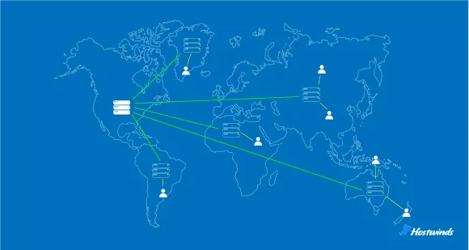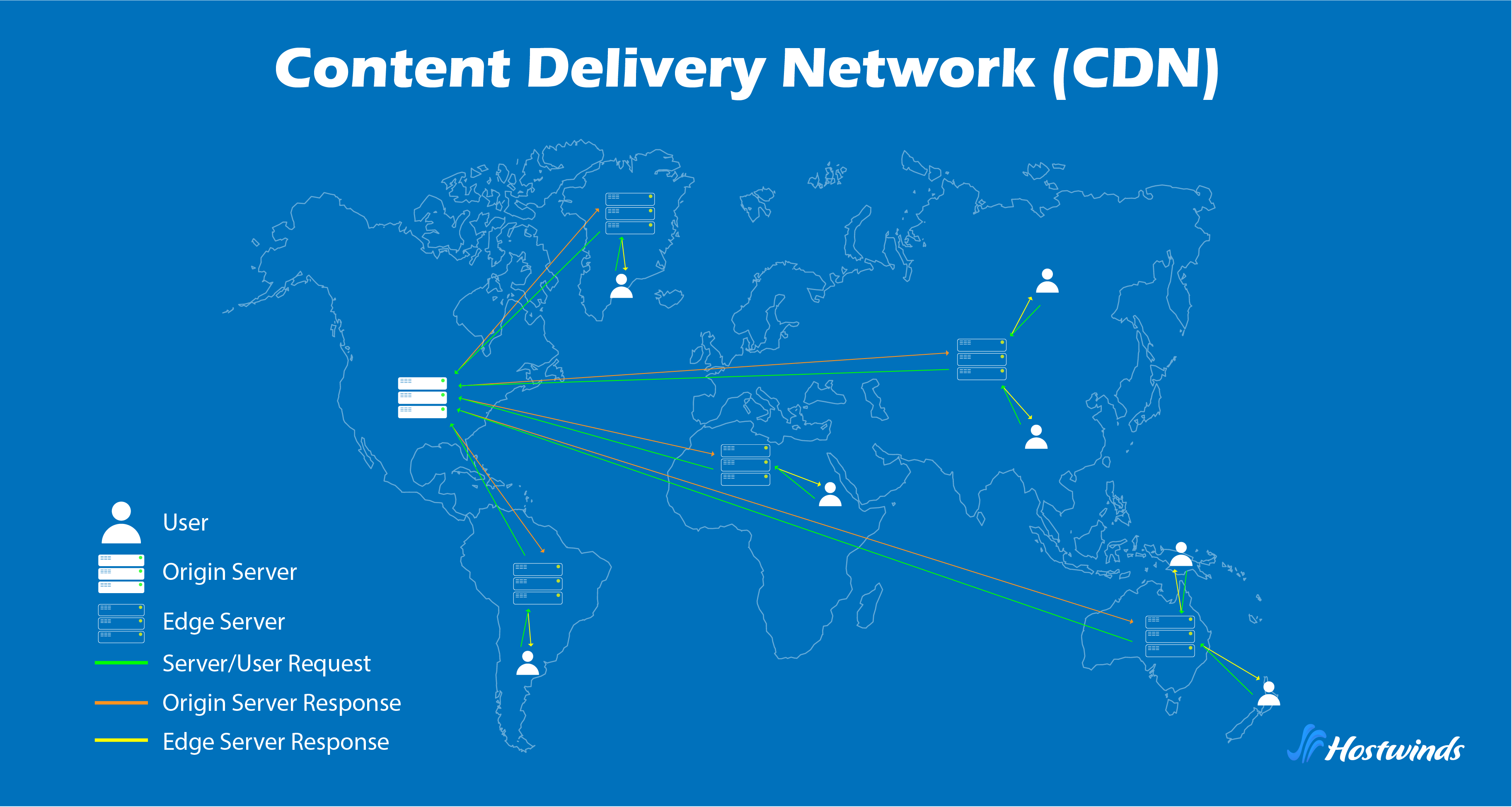Hostwinds Blog
Search results for:

What is a Content Delivery Network (CDN)? How Does it Work?
by: Hostwinds Team / March 13, 2024
What is a Content Delivery Network?
A Content Delivery Network (CDN) is a network of servers placed around the world used to cache website content, allowing websites to deliver their content more efficiently, regardless of the hosting server's geographic location.
The CDN Infrastructure
CDN providers operate an extensive network infrastructure consisting of high-speed connections, redundant data centers, and advanced routing technologies. This infrastructure ensures reliable and scalable content delivery by minimizing latency, packet loss, and downtime.
Here are the basic components that make up the CDN infrastructure:
Origin Server: The origin server is where the original version of the website's content is stored. This could be a web server, storage system, or cloud service where the content is hosted. When content is first requested, it is retrieved from the origin server.
Edge Servers: Edge servers are distributed across various locations worldwide and form the backbone of the CDN infrastructure. These servers are strategically positioned at the "edge" of the network, closer to end-users. Edge servers cache and deliver content to users quickly by storing copies of frequently accessed content locally. They also handle tasks like load balancing, content routing, and security.
Points of Presence (PoPs): Points of Presence are physical locations where CDN providers deploy edge servers. These PoPs are strategically chosen to ensure optimal coverage and performance for users in different geographic regions. Each PoP contains multiple edge servers and network infrastructure to handle incoming requests and deliver content efficiently.
Content Routing and Load Balancing: Content routing mechanisms determine the most efficient path for delivering content to users based on factors like geographic location, network conditions, and server availability. Load balancing techniques distribute incoming traffic across multiple edge servers to ensure optimal performance and reliability.
Caching Mechanism: CDNs use caching to store copies of static and dynamic content on edge servers. This helps reduce latency and bandwidth usage by serving content directly from the nearest edge server instead of fetching it from the origin server for every request. Caching policies and expiration rules dictate how long content is stored on edge servers before being refreshed or invalidated.
Security: CDNs offer various security features to protect content, applications, and users from cyber threats and attacks. These may include DDoS protection, web application firewalls, SSL/TLS encryption, access controls, and content security policies.
How does a CDN Work?
Now that we understand the CDN infrastructure, let's look at how a CDN fulfills a user's request:

- The user enters the website's domain name into their browser.
- The browser sends a DNS request to the DNS resolver to translate the domain name into an IP address.
- If the website is configured to use a CDN, the DNS resolver provides the browser with the IP address associated with the CDN's nearest Point of Presence (PoP), where an edge server is located.
- The browser sends a request to the IP address provided by the DNS resolver.
- If the requested content is cached on the CDN's edge server, it is served directly from there to the user's browser.
- If the content is not cached on the CDN's edge server or has expired, the CDN forwards the request to the origin server.
- The origin server responds by sending the requested content to the CDN's edge server.
- The CDN's edge server delivers the content to the user's browser.
- Subsequent requests for the same content may be served directly from the CDN's cache if it remains valid, reducing the need for repeated requests to the origin server and increasing load time for the user.
Throughout the entire process, the CDN applies security features such as DDoS protection, firewalls, and SSL/TLS encryption to protect against cyber threats and ensure the integrity and confidentiality of the data being transmitted.
Benefits of using a CDN
Content delivery networks can be a key component for websites with far reaching audiences.
Let's look at the core benefits that make CDNs so popular among websites and beneficial for users:
Improved Website Performance: CDNs cache content on edge servers located closer to end-users, reducing the distance data needs to travel and improving load times. This leads to faster website loading speeds and a smoother user experience.
Reduced Latency: By delivering content from nearby edge servers, CDNs minimize latency, or the delay between sending a request and receiving a response. This is especially beneficial for global audiences accessing content from distant locations.
Increased Reliability and Availability: CDNs distribute content across multiple servers and data centers, reducing the risk of downtime due to server failures or network issues. If one server goes down, the CDN can reroute traffic to other available servers, ensuring uninterrupted access to content.
Scalability: CDNs are designed to handle fluctuations in website traffic and sudden spikes in demand. By distributing content across a network of servers, CDNs can scale resources dynamically to accommodate increased traffic without impacting performance.
Bandwidth Savings: CDNs reduce the burden on origin servers by caching and serving content locally. This decreases the volume of data transferred over the network and lowers bandwidth costs for website owners, especially for high-traffic websites or large files like images and videos.
Global Reach: CDNs have a network of edge servers located in various geographic locations worldwide, allowing content to be delivered quickly and efficiently to users regardless of their location. This enables websites to reach a global audience and provide consistent performance across different regions.
Enhanced Security: Many CDNs offer built-in security features such as DDoS protection, web application firewalls, and SSL/TLS encryption. These features help protect websites and applications from cyber threats, unauthorized access, and data breaches.
Better SEO Performance: Faster loading times and improved website performance resulting from CDN usage can positively impact search engine rankings. Search engines like Google consider website speed as a ranking factor, making CDNs an essential tool for optimizing SEO performance.
Is a CDN the Same as a Web Host?
No, Content delivery networks are not the same as, nor can they replace, a web hosting service.
Instead, CDNs complement the services provided by web hosts by offloading traffic from their servers, improving scalability, and enhancing the overall user experience.
Should You Use a CDN?
Not all websites are going to need a Content delivery network, but if you're unsure whether or not a CDN would align with your website requirements and content delivery goals, consider the following factors:
Audience Reach: Evaluate the geographic distribution of your audience. If your users are spread across different regions or continents, a CDN can significantly improve content delivery speed and reliability by caching content closer to end-users.
Website Traffic and Performance: Analyze your website's traffic patterns and performance metrics. If your website experiences high traffic volumes, periodic spikes, or slow loading times, a CDN can help optimize performance, reduce latency, and enhance user experience.
Content Complexity and Size: Assess the type and size of content you deliver. If your website includes large files, multimedia content, or dynamic web pages, a CDN can efficiently cache and deliver this content, reducing bandwidth usage and improving loading times.
Written by Hostwinds Team / March 13, 2024
